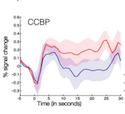Abstract
Creativity is widely recognized as an essential skill for entrepreneurial success and adaptation to daily-life demands. However, we know little about the neural changes associated with creative capacity enhancement. For the first time, using a prospective, randomized control design, we examined longitudinal changes in brain activity associated with participating in a five-week design-thinking-based Creative Capacity Building Program (CCBP), when compared with Language Capacity Building Program (LCBP). Creativity, an elusive and multifaceted construct, is loosely defined as an ability to produce useful/appropriate and novel outcomes. Here, we focus on one of the facets of creative thinking—spontaneous improvization. Participants were assessed pre- and post-intervention for spontaneous improvization skills using a game-like figural Pictionary-based fMRI task. Whole-brain group-by-time interaction revealed reduced task-related activity in CCBP participants (compared with LCBP participants) after training in the right dorsolateral prefrontal cortex, anterior/paracingulate gyrus, supplementary motor area, and parietal regions. Further, greater cerebellar–cerebral connectivity was observed in CCBP participants at post-intervention when compared with LCBP participants. In sum, our results suggest that improvization-based creative capacity enhancement is associated with reduced engagement of executive functioning regions and increased involvement of spontaneous implicit processing.
